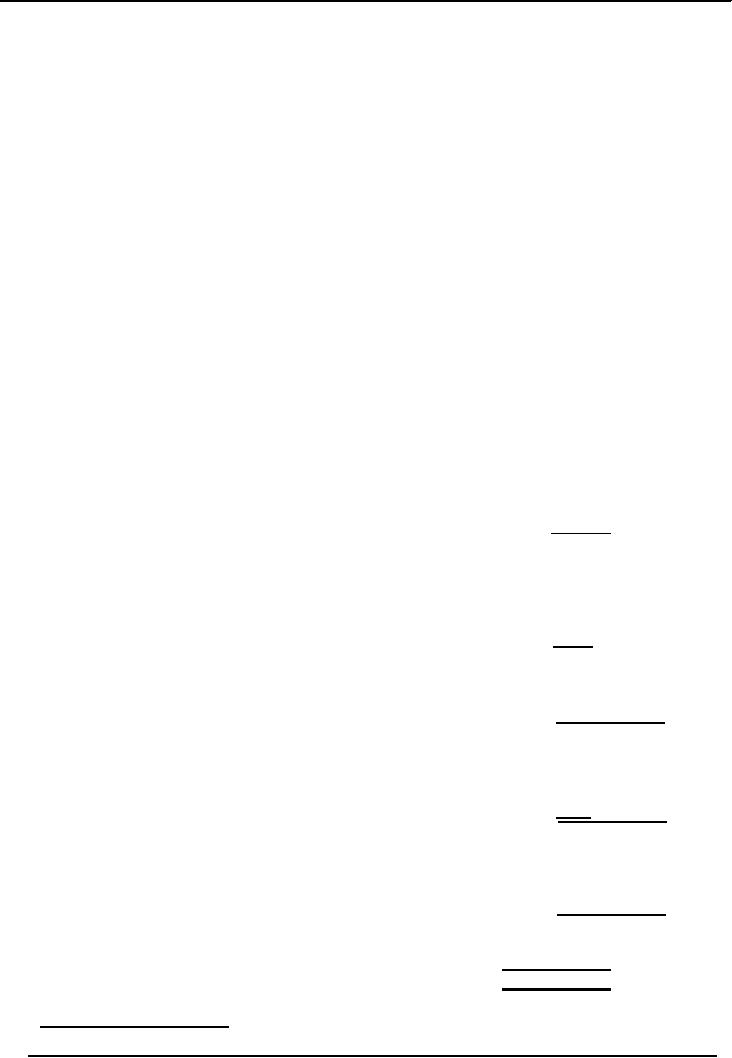 |
Cash Flow Statement |
| << Balance Sheet |
| Preparing Cash Flows >> |

Financial
Statement Analysis-FIN621
VU
Lesson-12
FINANCIAL
STATEMENTS
(Continued)
Cash
Flow Statement
Cash
flow statement shows, how
cash was generated and how
it was used during the
period. These days,
it is
required by law to include
this statement in financial
statements, especially in case of
financial
statements
of limited companies.
Need
For Cash Flow Statement
For
any business, it is important to
ensure that:
� Sufficient
profits are made to
compensate owners for the
investment made, efforts put
in and the
risk
taken for the
business,
� Sufficient
funds are available to meet
the obligations of the business as and
when required.
The
information as to profitability is
provided by the Profit and Loss
Account. The information as
to
availability
of funds or financial health is
provided by the balance sheet.
But the balance sheet
is
prepared on a
specific date and can
provide information of financial
position as on that date
only. Cash
flow,
on the other hand provides more detailed
information about the movement of funds
during the
period.
With the help of cash flow,
we can determine the amount of cash
generated form
different
sources
and the areas on which it is
utilized.
Difference
between Profitability and
Liquidity
Liquidity
It is the
ability of a business to pay
its debts in time. By having
good liquidity, we mean that
a business
has
sufficient liquid funds
(cash and cash equivalents)
so that it can repay
liabilities.
Cash
Cash
includes cash in hand and demand
deposits.
Cash
Equivalents
Cash
equivalents are those short
term investments that can be
converted into a known amount of
cash at
any
time. Usually, investments up to three
months maturity are included
in cash equivalents.
People
generally mix up profitability
with liquidity. One might
think that if a business has
earned, say,
One
Million Rupees of profit
than it should have approximately the
same amount of cash in
it.
But
mostly this is not the case.
Consider the following example:
� A
person starts a small
business with Rs.
10,000.
� He
purchases goods worth Rs.
20,000. Rs. 10,000 is paid
in cash and remaining is payable at
the
end of the
month.
� The
same day, all the goods
are sold on credit of two
months for Rs.
30,000.
� Now
if we draw a profit and loss
account at the end of the month, the
business has earned a
profit
of Rs. 10,000, considering no
expenses.
� But
at the same time, it is time to
pay to the Creditors, whereas
payment from debtor is not
due
yet.
� This
means that although the
business earned a profit of
Rs. 10,000 but it has no
cash to pay to
its
creditors.
� This
simple example helps us to understand
that liquidity is different
from profitability
� But
it is as important as
profitability.
46

Financial
Statement Analysis-FIN621
VU
Components
of Cash Flow Statement
Cash
flow statement is divided
into three components
� Cash
Flow from Operating
Activities
� Cash
Flow from Investing
Activities
� Cash
Flow from Financing
Activities
Cash
Flow From Operating
Activities
Cash
flow from operating
activities is generally derived
from the principal revenue producing
activities
of the
business.
Cash
Flow from Operating
Activities is the indicator of success or
failure of a business's operations.
If
the
cash flow from operations is
continuously negative, this
means that the business revenue is
not
enough
to recover the costs that are
incurred to earn it.
Therefore, in the long run
Cash flow from
operations
must be positive.
Examples of
cash flows from operating
activities are:
� Cash
receipt from sale of goods
and rendering of services.
� Cash
receipts from fees, commission and other
revenues.
� Cash
payments to suppliers for goods and
services.
� Cash
payments to and on behalf of the
employees.
� Cash
payments or refunds of income taxes.
EXAMPLE
Net
Profit before Tax
16,514
Add:
Adjustment for Non-Cash
Items
Depreciation
for the Year
5,500
Provision
for Doubtful Debts
810
Exchange
Gain / Loss
-
Gain
/ Loss on Disposal of
Assets
-
Return
on Investments
4,000
Mark-up
on Loans
3,500
Operating
Profit Before Working
Capital Changes
30,324
Working
Capital Changes
Add:
Decrease in Current
Assets
40,000
Less:
Increase in Current
Assets
(50,000)
Add:
Increase in Current
Liabilities
-
Less:
Decrease in Current
Liabilities
-
Cash
Generated From Operations
20,324
Less:
Markup paid on loans
(3,000)
Less:
Taxes Paid
(5,000)
Net
Cash Flow from Operating
Activities
12,324
Cash
Flow From Investing
Activities
Cash
flow from investing
activities includes cash receipts and
payments that arise from
Fixed and Long
Term
assets of the organization.
47

Financial
Statement Analysis-FIN621
VU
Cash
Flows from Investing
Activities shows the investment
trend of the business. If it is
negative
(Outflow)
this means that the company is
investing in long term assets
and is expanding. On the
other
hand if it is
positive (Inflow) over the
years, this means that the
company is selling its long
term
investments.
Examples of
cash flows from investing
activities are:
� Cash
payments to acquire property plant and
equipment. These also
include payments made
for
self-constructed
assets.
� Cash
receipts from sale of property
plant and equipment.
� Cash
payments and receipts from
acquisition and disposal of other
than long term assets
e.g.
Shares,
debentures, TFC, long term loans
given etc.
If
assets are held for
trading purposes or in normal
course of business e.g. car /
property dealers and
loans
given by banks, then cash
flow from these are
included in Operating Cash
Flow.
EXAMPLE
Cash
Flow from Investing
Activities
Add:
Disposal of Fixed Asset and
Long Term Investments
100,000
Less:
Acquisition of Fixed Assets and
Long Term Investments
(80,000)
Add:
Dividend Received / Returns on Investment
Received
-
Net
Cash Flow from Investing
Activities
20,000
Cash
Flow From Financing
Activities
Cash
flow from financing
activities includes cash receipts
and payments that arise
from Owners of the
business
and other long term liabilities of the
organization.
Cash
Flows from Financing
Activities shows the behavior of
investors (both equity capital and
debt
capital).
A positive figure (inflow)
shows that funds are
being invested in the company and vice
versa.
Examples of
cash flows from financing
activities are:
� Cash
received from owners i.e.
share issue in case of company
and capital invested by
sole
proprietor
or partners.
� Cash
payments to owners i.e. dividend,
drawings etc.
� Cash
receipts and payments for other
long term loans and borrowings.
EXAMPLE
Cash
Flow from Financing
Activities
Add:
Shares Issued / Capital
Invested
1,000,000
Less:
Dividend Paid /
Drawings
(400,000)
Add:
Increase in Long Term
Borrowings
150,000
Net
Cash Flow from Financing
Activities
750,000
Procedure
Of Preparing Cash Flow
Cash
Flow Statement is prepared as
follows:
� We
start from the Profit / Loss
for the period before
taxation.
� Adjustments
are made for non-cash items
that are included in the
profit and loss account such
as
Depreciation,
Provisions and other items
that relate to investing and
financing activities.
� This
gives us Operating Profit
before Working Capital
Changes.
48

Financial
Statement Analysis-FIN621
VU
�
Then
Working Capital Changes,
i.e. increase or decrease in items of
current assets and
liabilities,
are added / subtracted (Cash
and Cash Equivalents are
not included here)
�
This
gives the Cash Flow from
Operations.
�
To
this figure, we add / subtract
cash flows from investing
and financing activities.
�
This
gives us Net Increase /
Decrease in Cash and Cash
Equivalents.
�
To
this figure we add Opening Balance of
Cash and Cash Equivalents
(that we excluded
from
current
assets)
�
This
gives us the Closing Balance of Cash and
Cash Equivalents.
Increase
or Decrease is generally taken as
difference in opening and closing
balances of accounts
reported
in balance sheets.
FORM OF
CASH FLOW STATEMENT
Name of
the Entity
Cash
Flow Statement for the Period
Ending -----
Net
Profit before Tax
XYZ
Add:
Adjustment for Non-Cash
Items
Depreciation
for the Year
XYZ
Provision
for Doubtful Debts
XYZ
Exchange
Gain / Loss
XYZ
Gain
/ Loss on Disposal of Assets
XYZ
Return
on Investments
XYZ
Mark-up
on Loans
XYZ
Operating
Profit Before Working
Capital Changes
XYZ
Working
Capital Changes
Add:
Decrease in Current
Assets
XYZ
Less:
Increase in Current
Assets
(XYZ)
Add:
Increase in Current
Liabilities
XYZ
Less:
Decrease in Current
Liabilities
(XYZ)
`
Cash
Generated From Operations
XYZ
Less:
Markup paid on loans
(XYZ)
Less:
Taxes Paid
(XYZ)
Net
Cash Flow from Operating
Activities
XYZ
Cash
Flow from Investing
Activities
Add:
Disposal of Fixed Asset and
Long Term Investments
XYZ
Less:
Acquisition of Fixed Assets and
Long Term Investments
(XYZ)
Add:
Dividend Received / Returns on Investment
Received
XYZ
Net
Cash Flow from Investing
Activities
XYZ
Cash
Flow from Financing
Activities
Add:
Shares Issued / Capital
Invested
XYZ
Less:
Dividend Paid /
Drawings
(XYZ)
Add:
Increase in Long Term
Borrowings
XYZ
Net
Cash Flow from Financing
Activities
XYZ
Net
Increase / Decrease in Cash
and Cash Equivalents
XYZ
Add:
Opening Balance of Cash and Cash
Equivalents
XYZ
Closing
Balance of Cash and Cash
Equivalents
XYZ
IV) Statement of
cash flows. This
final Financial Statement
provides net results of cash
inflows
(receipts)
and cash outflows (payments)
during an accounting period.
Banks/creditors/investors look
for
49

Financial
Statement Analysis-FIN621
VU
this
statement, because it gives them a
picture of net cash flow of the
business. As already
explained,
positive
net income (profit) does not
necessarily mean increase in cash.
Therefore such statement
must
be prepared in
order to depict actual cash
position. It is clear that a highly
profitable business may
also
go
bankrupt. Therefore profitability
does not necessarily mean
solvency i.e. ability to pay
debts and
obligations.
This fact gives rise to the
need for preparing cash
flow statement.
Parts
of cash flow
statement
Cash
"flows" through a business
during accounting period by
Cash & Cash equivalent
(T-
bills,
saving certificates, bonds etc), and
through operating activities
which include, producing
or
delivering
goods for sale and providing
services, and also cash effects of
transactions and other
events
that
determine net income.
For
example Cash flows/collections
from sales and interest and
dividends received
would
be
cash Inflows. Similarly,
purchase of inventories and payment of
operating expenses would
constitute
cash
outflows.
Generating
positive cash from operations is the
preferred method to finance
capital
expenditure,
debt repayments and dividend
payments.
The
third method or process by which
cash "flows" through a
business is the group of
its
activities
called investing activities
which include short-term investments,
acquiring/disposing of
securities,
acquiring/disposing of plant assets, and
lending money/collecting
loan.
The
fourth method or process of cash
flow is the group of activities
called "Financial"
activities
which include borrowings
from creditors/repaying the principal,
obtaining resources
from
owners, and
providing owners with return on
investment.
The
fifth method or process of cash
flow in a business is of course the
effect of exchange
rate
fluctuations on cash.
To prepare
cash flow statement, look at
changes in all of balance
sheet accounts from
beginning to end
of
accounting period, and transfer the
changes to appropriate area of
cash flow statement.
Cash
Flow from operating
activities.
Inflows
in this case are: - cash
collections from customers,
Interest/dividends collected, and
other
operating
cash receipts e.g. proceeds
from litigations.
Outflows
would be, cash paid to
suppliers & employees, interest & taxes paid
and other
operating
cash payments e.g. payments in
litigations.
It
should be noted that receipt
and payment of interest are classified as
operating
activities
and not investing or financing
activities.
Net
of the "Inflows" and "Outflows", gives
cash flow from operating
activities.
Cash
flow from investing
activities:
Inflows
in this case are proceed
from sales of Certificates/ Securities,
proceeds from sales
of
Plant assets, and collection of loans
(principal).
Outflows
here would be purchase of
Certificates/Securities, purchase of
plant assets,
and loans
made to borrowers.
50

Financial
Statement Analysis-FIN621
VU
Net
of `Inflows' and `Outflows' gives
cash flow from investing
activities.
Cash
flow from financing
activities
Here,
the `Inflows' are proceeds
from borrowings, proceeds
from issuing "bonds
payable",
and proceeds from
issuing capital stock.
Outflows
correspondingly are payment to settle
debts (principal), and payment
of
dividends.
Net
of `Inflows' and `Outflows',
gives cash provided by
financing activities.
Sum
of net cash flows from all
the three activities viz Operating,
Investing and
Financing
gives overall cash flow
during the accounting
period.
Analysis
of Cash Flow Statement determines
firm's ability to generate
cash from
operations,
its capacity to meet cash
obligations and its future
financing needs. It indicates
firm's
success
in investing activities, and determines the
magnitude, fluctuations and causes of the
positive or
negative
operating cash flow.
51
Table of Contents:
- ACCOUNTING & ACCOUNTING PRINCIPLES
- Dual Aspect of Transactions
- Rules of Debit and Credit
- Steps in Accounting Cycle
- Preparing Balance Sheet from Trial Balance
- Business transactions
- Adjusting Entry to record Expenses on Fixed Assets
- Preparing Financial Statements
- Closing entries in Accounting Cycle
- Income Statement
- Balance Sheet
- Cash Flow Statement
- Preparing Cash Flows
- Additional Information (AI)
- Cash flow from Operating Activities
- Operating Activities’ portion of cash flow statement
- Cash flow from financing Activities
- Notes to Financial Statements
- Charging Costs of Inventory to Income Statement
- First-in-First - out (FIFO), Last-in-First-Out (LIFO)
- Depreciation Accounting Policies
- Accelerated-Depreciation method
- Auditor’s Report, Opinion, Certificate
- Management Discussion & Analyses (MD&A)
- TYPES OF BUSINESS ORGANIZATIONS
- Incorporation of business
- Authorized Share Capital, Issued Share Capital
- Book Values of equity, share
- SUMMARY
- SUMMARY
- Analysis of income statement and balance sheet:
- COMMON –SIZE AND INDEX ANALYSIS
- ANALYSIS BY RATIOS
- ACTIVITY RATIOS
- Liquidity of Receivables
- LEVERAGE, DEBT RATIOS
- PROFITABILITY RATIOS
- Analysis by Preferred Stockholders
- Efficiency of operating cycle, process
- STOCKHOLDERS’ EQUITY SECTION OF THE BALANCE SHEET 1
- STOCKHOLDERS’ EQUITY SECTION OF THE BALANCE SHEET 2
- BALANCE SHEET AND INCOME STATEMENT RATIOS
- Financial Consultation Case Study
- ANALYSIS OF BALANCE SHEET & INCOME STATEMENT
- SUMMARY OF FINDGINS